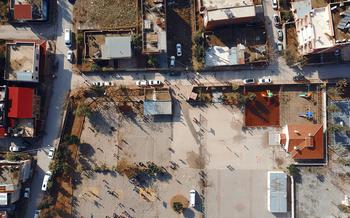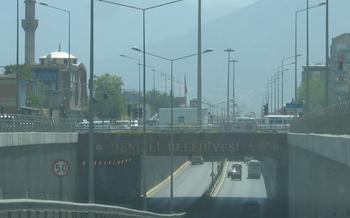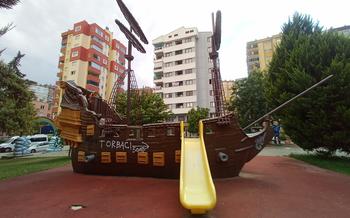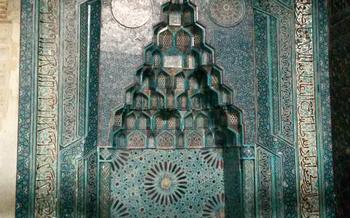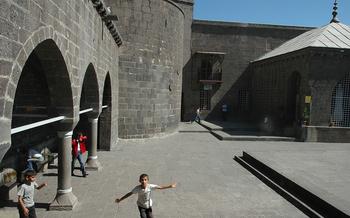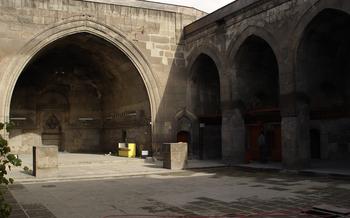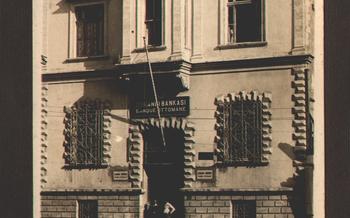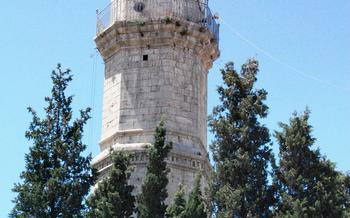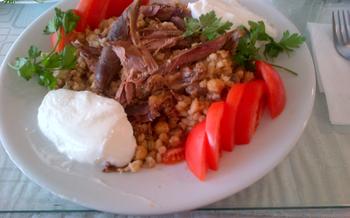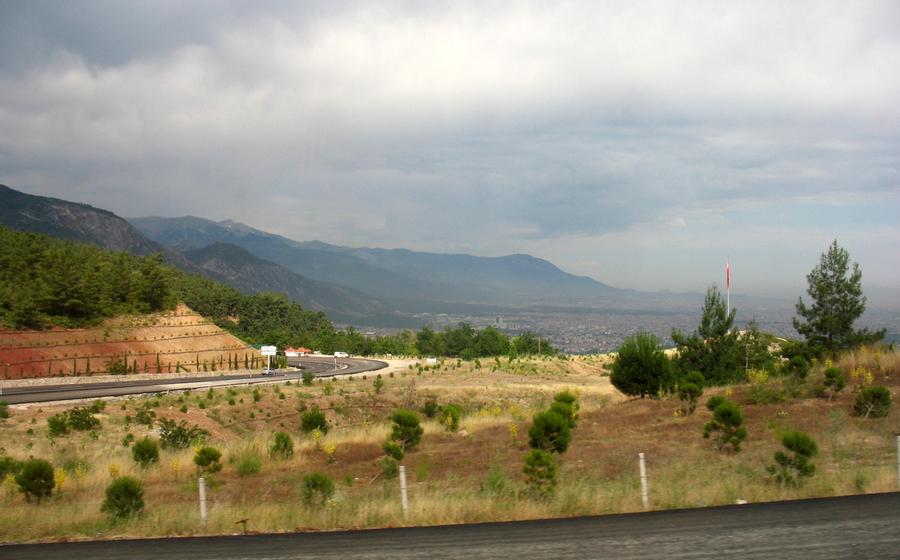
Kocabaş Mosque
- Historical Significance: A Legacy of Faith and Architectural Grandeur
- Architectural Marvel
- Prayer Hall Serenity
- Courtyard Oasis
- Visiting Hours and Etiquette
- Local Traditions and Customs
- Surrounding Attractions
- Photography Tips: Capturing the Essence of Kocabaş Mosque
- Local Cuisine Delights
- Souvenirs and Shopping
- Transportation Options
- Accessibility Features
- Language Considerations
- Safety and Security
- Insider Tip: Discover the Hidden Treasures of the Kocabaş Mosque
Historical Significance: A Legacy of Faith and Architectural Grandeur
Delve into the rich tapestry of history that unfolds at the Kocabaş Mosque, a testament to the enduring legacy of the Seljuk Empire in Denizli. Built in the 14th century, this architectural masterpiece stands as a symbol of the Seljuk's architectural prowess, blending Islamic traditions with Anatolian influences to create a unique and awe-inspiring structure. As you explore the mosque, you'll uncover intricate carvings, elegant calligraphy, and stunning tilework that narrate the story of a civilization that once ruled vast territories. Its minaret, a beacon of faith that pierces the skyline, is an iconic landmark that has guided generations of worshippers towards spiritual enlightenment. Discover the Kocabaş Mosque, where history and artistry converge to create a sacred space that continues to inspire and captivate visitors from around the world.
Architectural Marvel
The Kocabaş Mosque stands as a testament to the Seljuk architectural style, showcasing intricate details and a striking design. Its minaret, a prominent feature, exemplifies the significance of minarets in Islamic architecture, serving as a beacon for the faithful and a symbol of the mosque's presence in the cityscape. The use of traditional materials, such as stone and brick, adds to the mosque's authenticity and reflects the craftsmanship of the era. The mosque's exterior is adorned with intricate carvings and tilework, showcasing the artistic prowess of the Seljuk artisans. The combination of these elements creates a harmonious and visually stunning architectural masterpiece.
Prayer Hall Serenity
The prayer hall of the Kocabaş Mosque exudes an atmosphere of tranquility and serenity that invites worshippers to connect with their faith. The interior of the hall is adorned with intricate designs and decorations that create a visually stunning space. The walls are adorned with colorful tiles, intricate calligraphy, and geometric patterns that reflect Islamic art and craftsmanship. The high ceiling is supported by elegant columns, adding to the grandeur of the space.
The qibla wall, indicating the direction of Mecca, is a focal point of the prayer hall. It features a beautifully carved mihrab, a niche that symbolizes the presence of the Prophet Muhammad. The mihrab is adorned with intricate carvings and inscriptions that enhance its significance. The pulpit, where the imam delivers sermons, is located to the right of the mihrab and is adorned with similar craftsmanship.
During prayer times, the hall fills with the melodious voices of worshippers reciting verses from the Quran. The soft echo of their voices creates a harmonious ambiance that further enhances the tranquility of the space. The atmosphere of the prayer hall encourages worshippers to find solace, peace, and connection with the divine, making it a true sanctuary for spiritual reflection and devotion.
Courtyard Oasis
The courtyard of the Kocabaş Mosque serves as a tranquil and inviting space that complements the main prayer hall. Surrounded by high walls, the courtyard offers a serene escape from the bustling city outside. Its centerpiece is a beautiful garden that features a variety of colorful flowers, shrubs, and trees. The lush greenery creates a sense of tranquility, while the fragrant blossoms fill the air with a sweet aroma.
In the midst of the garden, a refreshing fountain provides a soothing sound and visual spectacle. The gentle flow of water creates a calming atmosphere, adding to the overall serenity of the courtyard. Visitors can find respite from the summer heat by sitting in the shaded areas of the courtyard, where comfortable seating is provided.
The courtyard also serves as a gathering place for the local community. During religious festivals and special occasions, the courtyard is transformed into a lively venue for celebrations and communal meals. It is a place where people can come together to socialize, share stories, and strengthen their bonds.
Whether seeking a moment of solitude or a chance to connect with the local community, the courtyard of the Kocabaş Mosque offers a welcoming and serene space.
Visiting Hours and Etiquette
The Kocabaş Mosque is open to visitors during designated hours, typically from early morning until sunset. It is essential to respect the mosque's sanctity and adhere to the appropriate attire and behavior when visiting. Modest clothing that covers the shoulders, knees, and chest is recommended for both men and women. Visitors should remove their shoes before entering the prayer hall and maintain a respectful silence. Photography is generally permitted, but it is important to be discreet and avoid using flash or disturbing worshippers. Visitors should also be mindful of any signs or instructions posted within the mosque. By observing these guidelines, visitors can ensure a respectful and enriching experience at the Kocabaş Mosque.
Local Traditions and Customs
The Kocabaş Mosque holds a special place in the hearts of the local community. For centuries, it has been a center of religious, social, and cultural activities. Locals frequently visit the mosque for daily prayers, religious gatherings, and special events. During the holy month of Ramadan, the mosque is particularly lively, with special prayers, community iftars (fast-breaking meals), and spiritual retreats. The mosque also plays a significant role in the city's cultural heritage, hosting events such as calligraphy workshops, poetry readings, and traditional music performances. Visitors are welcome to participate in these events and immerse themselves in the rich cultural tapestry of Denizli.
Surrounding Attractions
After exploring the beauty and tranquility of the Kocabaş Mosque, visitors can venture into the surrounding area to discover other historical and cultural treasures. One such attraction is the Denizli Castle, located just a short distance from the mosque. This impressive castle, built in the 15th century, offers breathtaking views of the city and the surrounding countryside. Visitors can climb the castle walls, explore its towers and chambers, and learn about its rich history.
Another must-visit destination is the Denizli Archaeological Museum, home to a vast collection of artifacts and relics from the region's ancient past. Visitors can marvel at the intricate carvings, sculptures, and pottery that tell the stories of civilizations that once flourished in this region. The museum also houses a collection of Islamic art and artifacts, providing further insight into the cultural heritage of Denizli.
For those interested in nature and outdoor activities, the Pamukkale Thermal Pools, located about 20 kilometers from Denizli, are a must-see. These unique travertine terraces, formed by the deposition of calcium carbonate from hot springs, create a surreal and breathtaking landscape. Visitors can swim in the mineral-rich waters, relax in the thermal pools, and enjoy the stunning views of the surrounding mountains.
To explore the natural beauty of the region further, visitors can embark on a scenic hike or bike ride through the Honaz Mountain National Park, located just outside Denizli. This park offers a diverse range of flora and fauna, with lush forests, cascading waterfalls, and panoramic views. Visitors can choose from various trails, ranging from easy walks to challenging hikes, making it accessible to people of all fitness levels.
Photography Tips: Capturing the Essence of Kocabaş Mosque
The Kocabaş Mosque offers a myriad of opportunities for capturing stunning photographs. To make the most of your photography experience, consider the following tips:
Best Angles and Lighting: - For exterior shots, position yourself at an angle that showcases the mosque's architectural symmetry and grandeur. - Visit during the golden hours (sunrise and sunset) to capture the mosque bathed in warm, diffused light.
Interior Details: - Use a wide-angle lens to capture the intricate details of the prayer hall, including the colorful tiles, calligraphy, and intricate carvings. - Pay attention to the natural light filtering through the windows, as it can create beautiful patterns and shadows.
Respectful Photography: - Remember that the mosque is a place of worship, so be respectful of worshippers and avoid causing any disruption. - Ask permission before photographing people, especially if they are engaged in prayer.
Drone Photography: - While drone photography offers a unique perspective, it is important to be mindful of local regulations and restrictions. - Check with local authorities before flying your drone, as there may be designated no-fly zones around the mosque.
Local Cuisine Delights
After immersing yourself in the spiritual and architectural wonders of the Kocabaş Mosque, tantalize your taste buds with the delectable flavors of Denizli's local cuisine. Denizli offers a culinary journey that will leave you craving for more. Indulge in the city's signature dish, keşkek, a hearty dish made from pounded wheat, meat, and spices, cooked to perfection in a traditional earthenware pot. Don't miss the opportunity to savor the unique taste of Denizli's gözleme, a thin flatbread filled with an array of savory ingredients like cheese, spinach, or minced meat.
For a sweet treat, try the city's famous badem ezmesi, a sweet almond paste delicacy that will satisfy your cravings. Denizli's restaurants and cafes offer a warm and welcoming ambiance, allowing you to immerse yourself in the local culture while enjoying the culinary delights. Whether you prefer a traditional Turkish breakfast, a leisurely lunch, or a delightful dinner, Denizli's culinary scene has something to offer every palate.
Souvenirs and Shopping
After immersing yourself in the spiritual and architectural wonders of the Kocabaş Mosque, you might want to take home a piece of the experience. Denizli offers a variety of shops and markets where you can find souvenirs and handicrafts related to the mosque.
-
Hand-woven Carpets: Denizli is renowned for its textile industry, particularly its hand-woven carpets. You can find beautiful carpets with intricate designs and vibrant colors, inspired by traditional Islamic patterns.
-
Ornamental Tiles: The mosque's stunning interior features intricate tile work. You can purchase decorative tiles with similar designs, perfect for adding a touch of Islamic art to your home.
-
Prayer Beads: Prayer beads, known as "tesbih" in Turkish, are an important part of Islamic tradition. You can find a variety of prayer beads made from different materials, such as wood, amber, or semi-precious stones.
-
Calligraphy Art: Islamic calligraphy is a highly respected art form. You can find shops selling beautiful calligraphy pieces, ranging from framed verses from the Quran to personalized nameplates.
-
Copperware: Denizli is famous for its copperware. You can find a variety of copper items, from traditional coffee pots to decorative plates and bowls, adorned with intricate patterns and designs.
Remember to bargain politely when shopping in local markets and always show respect for the local culture and customs.
Transportation Options
Reaching the Kocabaş Mosque from different parts of Denizli is a breeze, with several transportation options available. Embrace the local experience by hopping on the public transportation network, which offers a convenient and affordable way to travel. Buses and trams connect various parts of the city, and the mosque is easily accessible via these routes.
For a more personalized experience, opt for a taxi, readily available throughout Denizli. Taxis offer a comfortable and direct ride to the mosque, allowing you to sit back and enjoy the city's vibrant streets. Alternatively, if you prefer the freedom to explore at your own pace, consider renting a car. Several car rental agencies operate in Denizli, providing a range of vehicles to suit your needs.
Once you arrive at the mosque, you'll find ample parking facilities in the vicinity. Designated parking areas are available for both cars and buses, ensuring a hassle-free visit. Rest assured, your vehicle will be safe and secure during your time at the mosque.
Accessibility Features
The Kocabaş Mosque is committed to ensuring that all visitors, regardless of their abilities, can fully experience its beauty and tranquility. The mosque provides several accessibility features to accommodate visitors with disabilities.
Wheelchair users and individuals with limited mobility will find ramps and elevators strategically placed throughout the mosque, allowing them to navigate the premises with ease. Designated seating areas within the prayer hall are reserved for wheelchair users, ensuring they can participate in prayers comfortably.
In addition, the mosque staff is trained to assist visitors with special needs. They are available to provide guidance, assistance, and any necessary support to ensure a seamless and enjoyable visit for everyone. Visitors who require assistance or have specific accessibility needs are encouraged to reach out to the mosque staff for personalized assistance.
Language Considerations
English proficiency in Denizli is generally moderate, with some locals understanding basic English phrases. While it's helpful to learn a few Turkish words and phrases, such as greetings and common courtesies, it's not necessary for basic communication. Most tourist attractions, including the Kocabaş Mosque, have staff members who can assist with English inquiries. However, for a more immersive experience and to connect with the local community, consider using a translation app or hiring a local guide. Be prepared for some language barriers, especially in smaller shops or traditional neighborhoods. Embrace the opportunity to learn about Turkish culture and customs through these interactions.
Safety and Security
Denizli and its surrounding areas are generally safe for tourists. The city has a low crime rate, and locals are known for their hospitality and welcoming nature. However, as with any destination, it's essential to exercise common sense and take precautions to ensure your safety. Be aware of your surroundings, especially in crowded areas, and avoid walking alone at night. Keep your valuables secure and don't flash large amounts of money or jewelry. If you're traveling alone, consider joining a tour group or hiring a local guide. Overall, Denizli is a safe and welcoming city for travelers who take basic safety measures. So relax, embrace the local culture, and enjoy your visit to the Kocabaş Mosque and other attractions in this beautiful city.
Insider Tip: Discover the Hidden Treasures of the Kocabaş Mosque
Beyond its captivating architecture and serene ambiance, the Kocabaş Mosque holds a hidden gem that many visitors may not be aware of. Within the mosque's courtyard, nestled amidst the lush gardens, lies a secluded fountain known as the "Wishing Well." According to local legend, this fountain possesses magical powers. Visitors who toss a coin into the well and make a wish are said to have their desires fulfilled.
To experience the magic of the Wishing Well, simply find a quiet moment during your visit to the mosque. Step into the courtyard, let the tranquility wash over you, and approach the fountain. Close your eyes, make a heartfelt wish, and toss a coin into the water. As the ripples spread outward, allow yourself to believe in the power of this ancient tradition. Who knows, the Kocabaş Mosque's Wishing Well might just grant you your heart's desire.
